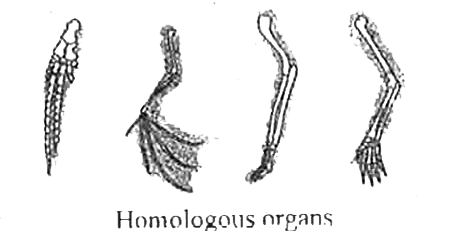Write a short note on analogous and homologous organs?Solution in Kannada
Homology: Homology is the reonship among organs of different groups of organisms, that show similarity in their basic structure and embryonic development, but perform different functions.
Homology of organs of different organisms indicates their common ancestry.
Homology is found in the bones of forelimbs of whales, cheetah, birds, amphibians and humans, they have similar basic anatomical structure with the bones humerus, radius,ulna,carpals, metacarpals and phalanges.
Other examples are the hearts and brains of vertebrates.
Among plants, the thorns of Bougainvillea and tendrils of Cucurbita represent homology.
Homology or homologous organs is/are the result of divergent evolutions, i.e., the evolutionary process where the same structure develops along different directions due to adaptations for different needs.
(ii) Analogy : Analogy is the relationship among organs of different groups of organisms performing the same function, irrespective of structural of anatomical differences.
Some examples of organs showing analogy are:
• Eyes of octopus and those of mammals.
• Wings of a butterfly (insect) and those of birds.
• Flippers of whales or dolphins and those of penguins.
Tubers of sweet potato (root modified) and those of potato (stern modified).
Analogy is the result of convergent evolution, i.e., the evolutionary process, where anatomically different structures in different groups of organisms evolve towards the same function. It is the similar habitat conditions that have selected similar adaptive features in different groups of organisms, towards the same function,

Topper's Solved these Questions
- BOOK - SUBHASH PUBLICATIONCHAPTER - EVOLUTIONEXERCISE - FIVE MARKS QUESTION3videos
EVOLUTION
- BOOK - SUBHASH PUBLICATIONCHAPTER - EVOLUTIONEXERCISE - TWO MARKS QUESTION8videos
EVOLUTION
- BOOK - SUBHASH PUBLICATIONCHAPTER - ENVIRONMENTAL ISSUESEXERCISE - FIVE MARKS QUESTIONS AND ANSWERS7videos
ENVIRONMENTAL ISSUES
- BOOK - SUBHASH PUBLICATIONCHAPTER - EXAM QUESTION PAPER JULY 2015EXERCISE - PART D12videos
EXAM QUESTION PAPER JULY 2015
Similar Questions
What was the experiment of Stanley Miller (1953) on the origin of life?
02:42View SolutionWhat is the significance of archacopteryx in the study of organic evolution?
03:48View SolutionWrite a note on groundwater depletion and ways for its replenishment.
03:28View Solution(a) Single cell proteins can be used as an alternate source of proteins for human nutrition. Illustrate with two examples.
(b) How can tissue culture be applied to recover healthy plants from virus-infected plants?03:58View SolutionHomologous and Analogous Organs
View SolutionHomologous organs and Analogous organs.
View SolutionWrite a brief note on homologous organs.
03:22View SolutionWrite a bref note on Homologos and analogous organs.
03:50View SolutionWrite a short note on homologous series.
02:20View SolutionWrite short notes on analogous and homologous organs?
02:20View SolutionWrite short note : Analogous organs
03:11View SolutionDistinguish between analogous organ and homologous organ.
02:41View SolutionWrite down the 1 difference between homologous and analogous organ.
02:36View SolutionWrite down the difference between homologous and analogous organ.
05:18View SolutionWrite difference between homologous and analogous organ based on - Origin
03:58View Solution

